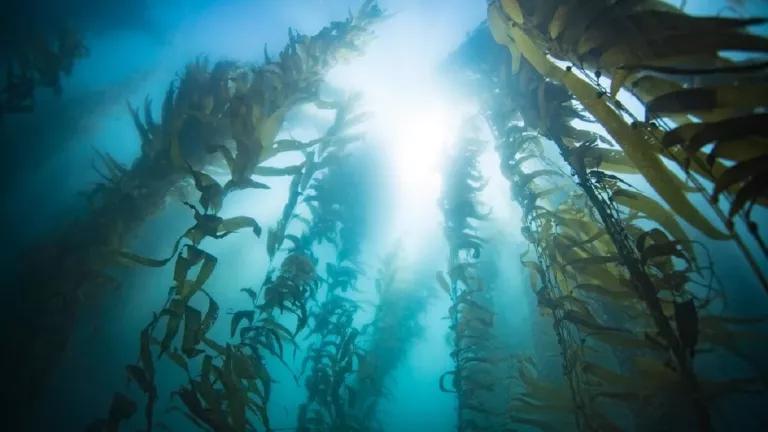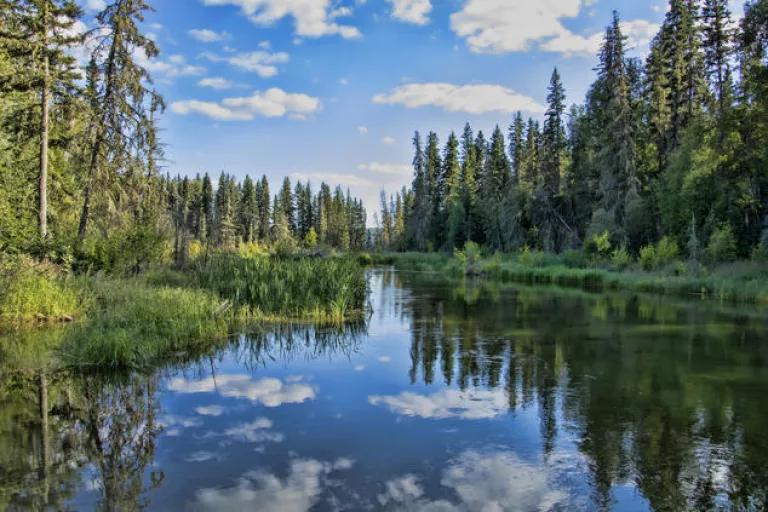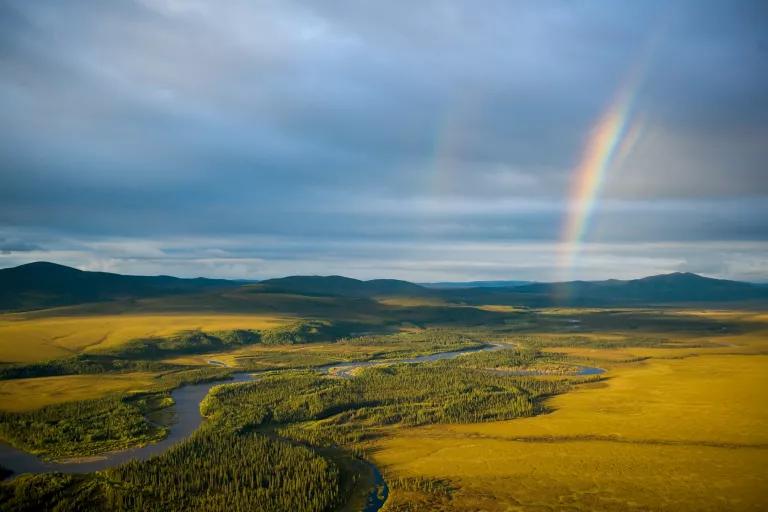Five Natural Climate Solutions to Mitigate Climate Change
The news from the latest IPCC report could be dispiriting (life-threatening climate changes are inevitable and irreversible) but it also continues to make the case that we can stave off the worst impacts of climate change if we drastically reduce emissions and remove carbon from the atmosphere. Much of the work that must be done to reduce emissions is clear, even if incredibly difficult.

Boreal Forest in Alaska
The news from the latest IPCC report could be dispiriting (life-threatening climate changes are inevitable and irreversible) but it also continues to make the case that we can stave off the worst impacts of climate change if we drastically reduce emissions and remove carbon from the atmosphere. Much of the work that must be done to reduce emissions is clear, even if incredibly difficult. As UN Secretary-General António Guterres said, “This report must sound a death knell for coal and fossil fuels, before they destroy the planet…. Countries should also end all new fossil fuel exploration and production.” But more must be done. The United States and other countries can immediately expand investment and support for natural climate solutions that provide the triple benefit of reducing emissions, taking carbon out of the atmosphere, and increasing the resiliency of the natural world.
Thriving natural ecosystems are great at storing carbon, so investing in their protection and restoration is a necessary step to reducing global warming. At the same time, healthy ecosystems are in a better position to withstand climate change impacts, which means they’ll be more likely to continue providing the foundational natural building blocks we rely upon for human life, like clean air, clean water, food security, and flood control.
Finally, one of the best things about natural climate solutions is that they provide an opportunity to bring everyone to the table. To avoid the mistakes of the past, we must include the voices of communities that have been and will be disproportionately burdened by the impacts of climate change and the industries creating our global warming nightmare. These include marginalized communities already suffering from flooding and fires and communities of color suffering from fossil fuel pollution—and those already leading the way on natural climate solutions, which include Indigenous and local communities that provide the connection between the needs of humanity and the natural climate solutions that can turn the tide. Too often, these groups have been left out of the decision-making process. By bringing them to the table and following their leadership, we can employ natural climate solutions that stand a better chance of achieving the enduring results needed to benefit all people.
Here are five things we can do immediately:
Protect Our Best Climate Ally: The Ocean

A kelp forest off the coast of La Jolla, California
The ocean has already been our best ally in combating climate change. It has absorbed carbon at an incredible pace—limiting the amount in the atmosphere and, thus, the amount of warming—and it has absorbed a massive amount of the heat generated by global warming. So, it’s a shame unscrupulous industries have been treating it poorly for so long—plastic pollution, deep-sea mining, illegal and unregulated fishing, etc. But we can have the Ocean’s back by setting aside enough targeted ocean areas to give it room to rejuvenate and strengthen. That’s why ambitious ocean protection is a critical element of the global movement to conserve 30 percent of the globe by 2030 (30x30). For the ocean, that means fully and highly protecting 30 percent of the ocean by 2030.
Protect and Restore Forests

Boreal Forest
Fossil fuels are not the only culprit in our climate fight. So too is the loss of climate-critical forests. As stated by UN Secretary-General António Guterres in reference to today’s report, “greenhouse gas emissions from fossil fuel burning and deforestation are choking our planet and putting billions of people at immediate risk.” That’s why it’s critical that we stop destroying our remaining forests and it’s something we can do right here in the United States and demand from our northern neighbor, Canada. Canada’s boreal forest stores twice as much carbon as the world’s oil reserves and U.S. forests collectively absorb the equivalent of about 12 percent of the nation’s annual carbon pollution. While much of the international community’s focus has been on protecting forests in the tropics, countries in the Global North are driving some of the fastest primary forest loss in the world. Canada, the United States, and other Northern countries must look beyond tree planting and protect the carbon-rich forests and trees already playing such an important role in the climate fight.
Riparian forests are also champion carbon sequesterers, rivaling tropical and boreal forests for the amount of carbon stored. But many of our streamside forests have disappeared, having been plowed under for development, denuded for levee maintenance, or cleared for agriculture. Restoring these critical forests helps fight climate change, protect our water quality, reduce flooding, and provide corridors for wildlife to safely migrate from one area to another.
Embrace Regenerative Agriculture

Alley cropping
Farmers are already experiencing some of the harshest impacts of climate change, dealing with higher temperatures, drought, erratic weather, and fires; and of course, agriculture itself is responsible for significant greenhouse gas emissions. But we shouldn’t discount farmers as inevitably part of the “climate dread” portion of this story. Instead, we should invest in strategies that can help agriculture become part of the climate solution. According to the National Academy of Sciences, U.S. agricultural soils have the potential to sequester 250 million metric tons of carbon dioxide-equivalent greenhouse gasses annually—equivalent to the annual emissions of 64 coal fired power plants. And many of the same practices that help the soil store more carbon also make farms and ranches more resilient to climate change, support wildlife habitat, and produce healthier food—and are time-tested techniques that Indigenous farmers and ranchers have used for many generations. We can make the shift toward a healthier and more sustainable agriculture system by ensuring that farmers have the resources and tools they need to adopt regenerative agriculture practices, including planting cover crops to protect and improve the soil, restoring “buffers” along the streams and rivers that run through farms and ranches, and reducing their reliance on fossil fuel-derived fertilizers and pesticides.
Officially Induct Wetlands in the Climate Change Fight

Wetland in Arlington, Virginia
Since 1700, the globe has lost more than 85 percent of its wetland areas. That’s not good news for the climate, because wetlands store an incredible amount of carbon, holding between 20 and 30 percent of the carbon found in world’s soil. We’re not going to meet our climate goals if we degrade the world’s remaining wetlands, reducing their current carbon storage and decreasing their ability to store more. But there are things we can do right now to protect existing wetlands, like undoing Trump’s rollback of the Clean Water Act, and bringing back old wetlands to their former glory, by investing in restoration through efforts like a Civilian Climate Corps.
Dedicate More Land Areas to Nature

A rainbow arcs over the Selawik River in Alaska's Selawik National Wildlife Refuge
Steve Hillebrand/USFWS
Perhaps by now you’re recognizing a theme when it comes to natural climate solutions: Protect more areas already making meaningful climate contributions and those with the potential to do even more if properly conserved. For several years now, scientists have been zeroing in on the amount of the globe that must be protected from some of the worst industrial abuses. Increasingly, that discussion has focused on protecting half the earth by mid-century, and the road to get there is to protect 30 percent of the world’s land by 2030. Scientists have zeroed in on this in part to secure the world’s biodiversity, but also as necessary to combat climate change. Thus, the reference to a “global safety net” in the 2020 paper, “A ‘Global Safety Net’ to reverse biodiversity loss and stabilize Earth’s climate.” If we conserve enough representative ecosystems, we can reverse terrestrial biodiversity loss, limit future carbon emissions from land conversions, and bolster natural carbon removal. President Biden recognized the importance of 30x30 for climate change when he included it in his climate change executive order. That work has begun and must continue.
* * *
There’s a certain allure bound up in climate nihilism: we’re doomed and there’s nothing we can do. Hogwash. We aren’t doomed yet and there are so many things people and policymakers are already doing and so much more that must be done. Every pound of carbon pollution already locked up in nature or pulled out of the atmosphere reduces the harmful impacts of climate change. And everyone has work to do. One of the easiest thing we can do is recognize nature as the ally it is in the climate fight and embrace the natural world’s power to fight climate change and save biodiversity by using the solutions shared here.




